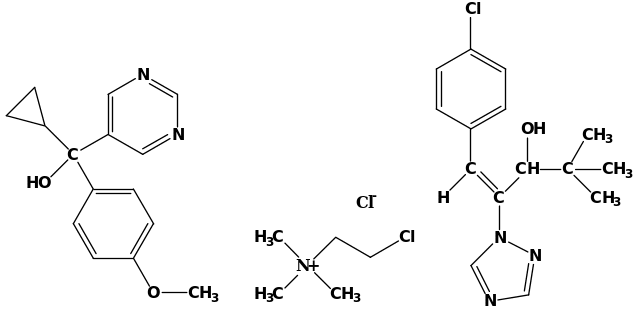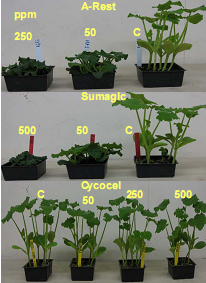Abstract
Pumpkin seeds were soaked in presence of three growth retardants and then germinated and planted. The plant height was significantly reduced in case of A-Rest and Sumagic but not Cycocel treatments. This suggests that the gibberellin-antagonistic plant growth retardants’ effects may vary depending on the species being investigated.
Introduction and Objective
According to Funkhouser, Plant growth regulators are chemicals which, when present in plants in extremely small quantities, considerably modify growth. When they are produced by plants themselves they are called phytohormones (72-77). These phytohormones are classified on the basis of physiological response that they elicit. Auxin, gibberellin, ethylene, cytokinin and abscisic acid are known as five “classical” phytohormones (Kende & Zeevaart 1197-1210). Plant growth is based on cell production in apical or intercalary meristems, and hormones regulate both cell division and cell elongation in this tissue (Francis & Sorrell 1-12).
Auxins and gibberellins stimulates G2 phase of cell cycle to enter into mitosis by modulating action of cell cycle regulatory proteins, serine/threonine protein kinases and cyclins. Cytokinins increase cell division by enhancing chromosomal replication events at S phase and transforming resting cells from G0 to G1 phase. These hormones especially gibberellins promote cellular water intake and extend the cytoskeleton, the transversely oriented cellulose microfibrils. Li further established that seed germination and root growth is facilitated by gibberellins (199). Ethylene causes thickening of stems by reorienting microfibrils to longitudinal/oblique position. Abscisic acid is a potent antagonist of gibberellin action and induces stunted growth. The other functional classes of plant growth regulators, mostly available as synthetic products, are: defoliants, anti-auxins, ethylene inhibitors, ethylene releasers, morphactins and growth retardants.
Growth retardants like Sumagic, Cycocel and A-Rest are the synthetic formulations used for controlling the natural growth habit of plants in Nursery (Fig. 1). They regulate height and encourage branching and bushiness yielding a thick short canopy for ornamental purpose. According to Al-Rumaih & Al-Rumaih, these chemicals without affecting the foliar and floral development stunt plant growth by decreasing internode elongation (450-453). Most of them inhibit one or many steps of gibberellic acid biosynthesis, for e.g. the ent-kaurene oxidase enzyme, a cytochrome P450 monooxygenase (Hedden & Phillips 523-530). Moreover, retardants like A-Rest (Ancymidol) also interfere with cellulose synthesis affecting longitudinal orientation of cellulose microfibrils (Hofmannova et al. 3965). Magnitskiy elaborately investigated and concluded that from seed germination to plantation any agent that affects gibberellic acid synthesis would invariably retard plant height (1-157).
The objective of the exercise was to test whether or not certain standard growth regulators as listed below (retardants) affect pumpkin seed germination and plant growth. Our null hypothesis is that there will be no difference against the control untreated plants (H0).


Materials and Methods
We used Giant Pumpkin (Cucurbita pepo cultivar “Gladiator”) seeds with uniform edge and color and without any cracks, molds. The complete standard procedure promoted by Pumpkin Seed Germination and Pumpkin Germination Tutorial was followed. Applying a sanding block the edge was rubbed softly until the upper layer was pealed off and half seed line was visible. As controls we placed 8-10 seeds in three Petri dishes each containing ca. 30 ml of distilled water to which 3 ml of 3% solution of H2O2 was added (final H2O2 conc. 0.3%), which is a standard soaking solution. Uniconazole-P in the Sumagic™ formulation contains 0.05% (500 ppm) active ingredient, Ancymidol in the A-Rest™ formulation contains 0.0264% (264 ppm), and Chlormequat in the Cycocel™ formulation contains 11.8%. Working solution of Cycocel™ was prepared by diluting the formulation (1 ml) with 250 ml soaking solution (final chlormequat conc. = 0.05%). Working solutions of Sumagic™ and A-Rest were the original formulations to which H2O2 was added as for the controls. For attaining 500 ppm the working solutions of Sumagic and Cycocel original formulations were directly dispensed in Petri dishes, and for 250 and 50 ppm this were diluted with soaking solution by 1/2 and 1/10 times. A-Rest was as such diluted and series of only 250 and 50 ppm could be dispensed in the Petri dishes. The seeds were soaked for 6-10 min under dim light.
A few sheets of paper towel were soaked in the soaking solution and the soaked seeds were wrapped for germination (sprouting) at 29-31oC in plastic household storage container with folded up heating blanket at the top. Within 24-36 h the non-sprouting seeds were discarded. Garden soil mixed with small quantity of compost and ash from fireplace was filled in 1’ × 1’ × 0.5’ peat pots. The date of plantation was 24-25 February, 2009. Five seeds from each treatment group (including corresponding controls) were planted about 2”-3” deep in the pots and they were labeled by blue tag (A-Rest group), yellow tag (Cycocel group) and red tag (Sumagic group). The round end of seed coat was placed down if sprout tips were bent and pointed tip of the seed coat were kept down if sprouting was erected and immature. These pots were thoroughly watered. Within 4-6 d seedlings emerged from the soil surface and now pots were kept under 18 h photoperiod (white light; 50-70 µE m-2 s-1) at 24oC and 6 h darkness at 18oC. At the time of sampling the plants were cut at soil line and after cleaning adhered soil with drawing brush length were measured with a meter scale.
To determine significant difference in treated plants from control plants in each treatment set, one-way ANOVA was applied. F-values were calculated from the data and compared with the tabulated F values for three levels of significance, 0.05 p, 0.01 p and 0.001 p. If Fcal was greater than Ftab than null hypothesis was rejected, which means there was significant difference in that treated samples compared to controls. To find the deviation between means of control and the treatments and between the treatments within each group the t-values for the means were calculated and using Tukey’s Post hoc test LSD was calculated. Most of the statistical treatments could be done using MS Excel® program.
Results

Table 1: Effect of soaking of Pumpkin seeds with plant growth retardants (5 seeds per treatment) on plant heights
Z A-Rest: p = 0.0025; mean separation within all columns by LSD, p < 0.05 (n = 5)
Y Sumagic: p = 0.0031
X Cycocel: p = 0.8695

The effect of three plant growth retardants at given concentrations is shown in Plate 1. It can be seen that the plants were retarded once the seeds were impregnated with Sumagic and A-Rest compared to the controls. The retardation was more pronounced at higher concentrations. Visibly, the dwarf plants exhibited thick foliage of smaller leaves and superior pigmentation (green) than the controls. In contrast, the control and Cycocel treated plants were tall with almost same height, foliage and pigmentation. The results presented in Table 1 and Fig. 2 indicates that between the controls there was no significant difference in plant heights (25.27 ± 1.27 cm). A-Rest and Sumagic-treatments caused significant reduction in plant heights compared to controls (p < 0.05).
The heights of the treated plants were ca. 60% lesser to controls. From the table it can be seen that the lowest concentration tested was sufficient to achieve the maximum growth reduction and increasing concentration had no additional effect. On the other hand there was no significant difference in case of Cycocel treatments, and the plant heights were nearly similar to the controls. In the table footnote the figures represent the estimated deviation of a treatment group by LSD analysis. The lower values of calculated p (0.0025, 0.0031) with respect to p level used for ANOVA (0.05) in A-Rest and Sumagic-treatments indicate significant deviation between the treatments. Conversely, the higher calculated p (0.8695) in Cycocel treatment indicates that not much deviation occurred between the treatments.
Discussion
We have applied standard procedures for the treatments, sprouting, germination and plantation and for statistical analysis to prove/disprove our hypothesis. From the statistical analysis (ANOVA) it is clear that our null hypothesis is rejected for A-Rest and Sumagic treatments as there was significant difference from the controls. But the hypothesis was accepted for Cycocel treatment due to non-significant difference. Interestingly, even within a single plant growth retardant group the deviation between the treatments was significant in case A-Rest and Sumagic and not Cycocel. Hence, though the plant height reduction seemed same at all concentrations of one treatment, statistically there was difference in the plant heights at different concentrations. In one of the set of experiments with A-Rest and Sumagic (Plate 1) we did find that the dwarfing effect of 50 ppm was less pronounced compared to the higher concentrations. The greener leaves in dwarf plants could be due to even distribution of chlorophyll in smaller leaf area, meaning that chlorophyll synthesis was not affected. Improvised phenotype has been correlated with dwarfism in plants (El-Mokadem & Heikal 331-342).
Hence, a significant outcome of the work is that despite all plant growth retardants antagonize gibberellin synthesis and plant growth, there are variations in response which depends on concentration, mode of action of the retardant and plant species. In pumpkin, gibberellin synthesis is highly tissue specific, and pathways operative in seed endosperm and growing embryo is different from what is present in hypocotyle and root tips in seedlings (Lange et al. 213–223). It is likely that gibberellin synthesis in pumpkin seeds is affected by A-Rest and Sumagic but not by Cycocel. The poorly germinated seeds eventually develop in dwarf plants. Cycocel may be effective at seedling stage and during plantation its concentration gets diluted to a non-effective concentration. Another explanation is that at given concentrations Sumagic and A-Rest may exert an antagonistic effect on seed germination and plant growth independent of gibberellin biosynthesis whereas Cycocel remains totally ineffective. It has been shown that at high concentration A-Rest (Ancymidol) is capable of inhibiting cellulose synthesis without affecting gibberellin production. Likewise, Sumagic (Uniconazole) may affect action of phytohormones other than gibberellins.
In conclusion, while A-Rest and Sumagic are very effective plant growth retardants in pumpkin, Cycocel seems to be ineffective. Apparently the effect is primarily at seed germination stage and may not be necessarily related to gibberellin biosynthesis in the developing seeds. Further study on course of action is desirous.
References
Al-Rumaih, May M., and Muna M. Al-Rumaih. “Physiological response of two species of datura to uniconazole and salt stress.” Journal of Food, Agriculture & Environment 5.3&4 (2007): 450-453.
El-Mokadem, Hoda E., and A. Hadia Heikal. “Induction of Dowrfism in Encelia farinosa by Cycocel and Evaluation of Regenerants Using RAPD and ISSR Markers.” Australian Journal of Basic and Applied Sciences 2.3 (2008): 331-342.
Francis, Dennis, and David A. Sorrell. “The interface between the cell cycle and plant growth regulators: a mini Review.” Plant Growth Regulation 33 (2001): 1–12.
Funkhouser, Edward. A. Laboratory Exercise in Plant Physiology. Lexington MS: Ginn Press, 1986.
Hedden, Peter, and Andrew L. Phillips. “Gibberellin metabolism: new insights revealed by the genes.” Trends in Plant Science 5.12 (2000): 523-530.
Hofmannova, Jana, et al. “A novel, cellulose synthesis inhibitory action of ancymidol impairs plant cell expansion.” Journal of Experimental Botany 59.14 (2008): 3963–3974.
Kende, Hans, and Jan A. D. Zeevaart. “The Five “Classical” Plant Hormones.” The Plant Cell 9 (1997): 1197-1210.
Lange, Theo, et al. “Gibberellin Biosynthesis in Developing Pumpkin Seedlings.” Plant Physiology 139 (2005): 213–223.
Li, Weiqiang, et al. “Hormonal and environmental regulation of seed germination in flixweed (Descurainia sophia).” Plant Growth Regulation 45 (2005):199–207.
Magnitskiy, Stanislav V. Controlling seedling height by treating seeds with plant growth regulators. Ph.D. dissertation. 2004. The Ohio State University. Web.
Pumpkin Seed Germination. PumpkinNook. 1998-2009. Premier Star Co. Web.
Rivington, Jordan. Pumpkin Germination Tutorial. 2005. Giant Vegetable Growers of Ontario. Web.